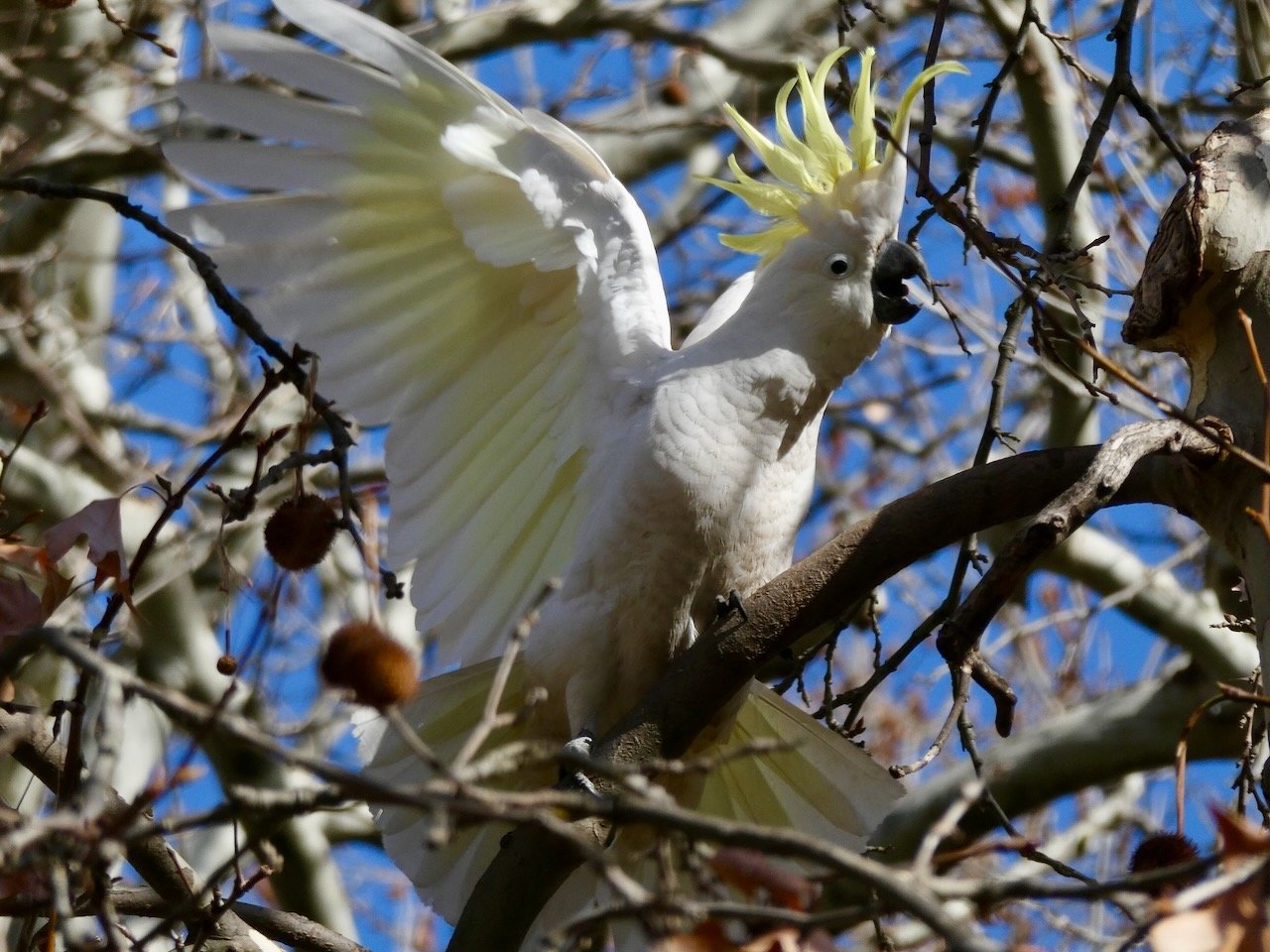by Nicholas Munday, Adelaide Urban Birding
Welcome to another story in our ‘What bird is that?’ series, about feathered friends in your Adelaide Park Lands.
The subject of this article is probably one of the best-known (although, not necessarily best-loved) birds in the country – the iconic sulphur-crested cockatoo.
Large, loud and bold, these birds are unmistakable when they descend en masse in your Adelaide Park Lands as evening draws in.
The sulphur-crested cockatoo (Cacatua galerita) is familiar to Australians as both a wild and an aviary bird and is one of the most popular of Australia’s bird exports in the international pet trade.
Like all cockatoos, they are fiercely intelligent and also easily bored, which often manifests as aggression in caged birds. Fortunately, we are lucky enough to see these clever birds in wild settings where their intelligence can flourish (often at the expense of our infrastructure!).
Sulphur-crested cockatoos at Victoria Park / Pakapakanthi (Park 16). The front bird displays the impressive, titular ‘sulphur crest’. Photography by Nicholas Munday, Adelaide Urban Birding.
Cockatoos are some of the largest (and loudest) members of the parrot clade (Psittaciformes), although some, like the dainty cockatiel (Nymphicus hollandicus), do buck this trend.
Australia is home to 14 species, including some of the largest in the world, such as the palm cockatoo (Probosciger aterrimus) of Cape York in Queensland, or the yellow-tailed black cockatoo (Zanda funerea), which can be found in your Adelaide Park Lands.
While the sulphur-crested cockatoo doesn’t quite reach record-breaking sizes, it is still, undeniably, a big and extremely strong bird.
Cockatoos display the traits familiar to all parrots – those being, zygodactyl (two-toed) feet, and strong, curved beaks – but also introduce another trait uniquely their own: a flamboyant crest used for display. In the sulphur-crested cockatoo, this crest is particularly pronounced, and iconically so.
Many of Australia’s cockatoos (the majority, even) are facing serious population decline due to continued habitat degradation and loss.
Contemplating its next move! A sulphur-crested cockatoo in Botanic Park (Park 11). Photography by Nicholas Munday, Adelaide Urban Birding.
However, sulphur-crested cockatoos are one of a handful that are actually on the increase (along with the equally familiar galahs and little corellas, also residents of your Adelaide Park Lands).
Part of the birds’ success in urban areas is their generalist diet and distinctly acute intelligence, often cited as being on par with a four- or five-year old child!
This intelligence has been used to frustrating effect in Sydney, where sulphur-crested cockatoos have become notorious in their knack for breaking into wheelie bins to access kitchen scraps, no matter what measures are put in place to deter them.
In Adelaide, along with the similar-looking and closely related little corella (Cacatua sanguinea), they are often known to cause havoc, chewing on electrical coverings and window sealant.
‘Bird-brained’ takes on a different meaning when a cockatoo is in the room.
A sulphur-crested cockatoo in Botanic Park (Park 11).
In addition to the unmistakable white plumage and sulphur-yellow crest, the raucous cry (or scream) of the sulphur-crested cockatoo is about its most defining trait. These birds seldom go anywhere quietly.
Despite their antics, the cockatoos are capable of displaying a delicate, tender side. Like most parrots, they form close, familial ties and usually mate for life.
Within Your Adelaide Park Lands, sulphur-crested cockatoos can be found regularly at Park 11 (Botanic Park in particular), Rymill Park / Murlawirrapurka (Park 14), and in large numbers at Victoria Park / Pakapakanthi (Park 16) and Carriageway Park / Tuthangga (Park 17).
To find out about other birds in your Adelaide Park Lands, check out our What Bird is That? series.
A ‘crackle’ of cockatoos in Bullrush Park / Warnpangga (Park 10). Photo: Shane Sody.
***
Main photo (top): Sulphur-crested cockatoo at Victoria Park / Pakapakanthi (Park 16) by Nicholas Munday, Adelaide Urban Birding.
***
Nicholas Munday is an environment and planning lawyer, with degrees in law and science (evolutionary biology and ecology) from the University of Adelaide.
He has a strong interest in biodiversity conservation and runs the ‘Adelaide Urban Birding’ Instagram (@adelaideurbanbirding) account, dedicated to his photography of native birds in the Adelaide metropolitan area.
In his free time, Nicholas is well-known in the Adelaide choral music and theatre communities, and also enjoys bushwalking, writing, and, of course, photography.
The opinions expressed in this article are entirely those of the author. This author is not affiliated with the Adelaide Park Lands Association.








